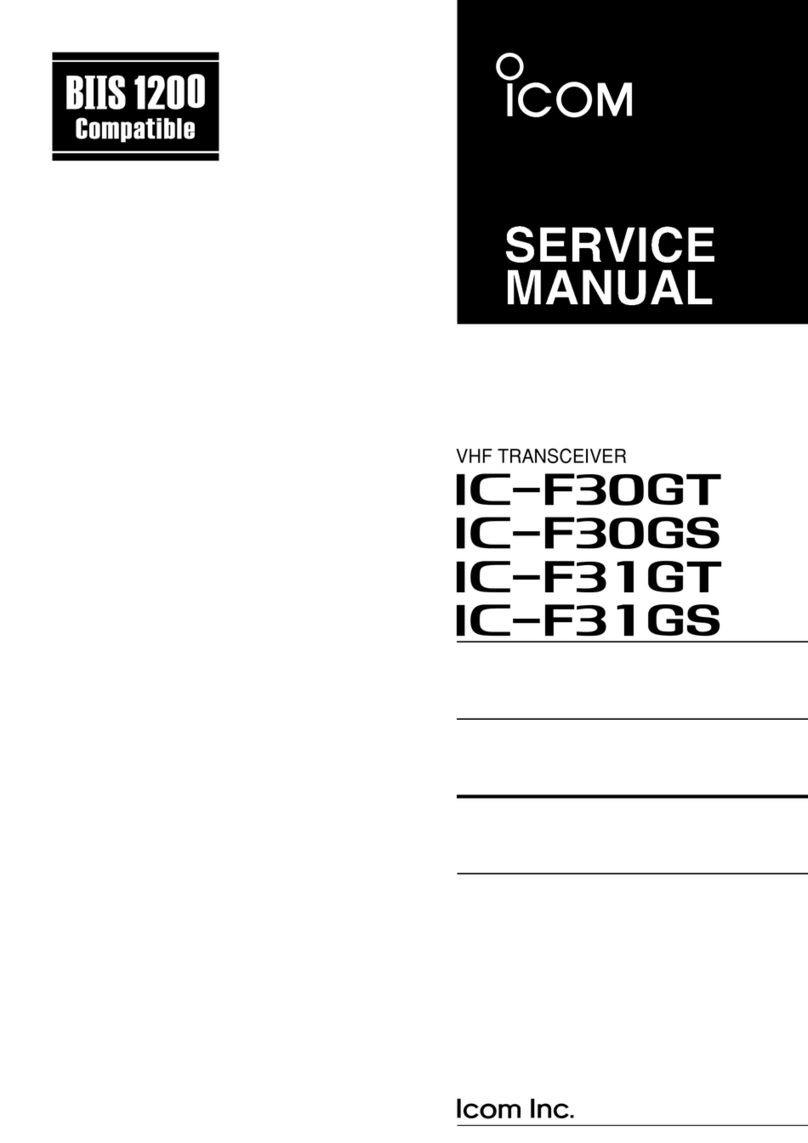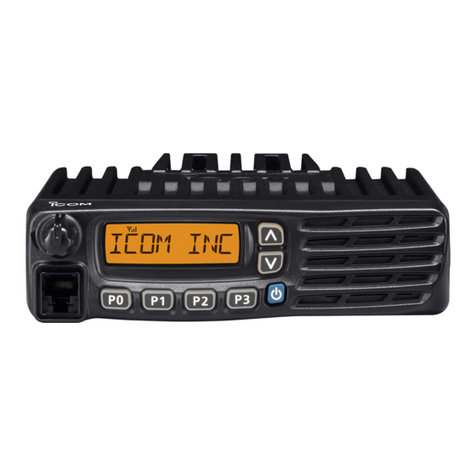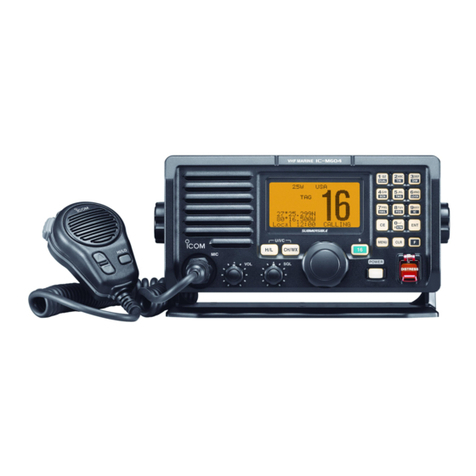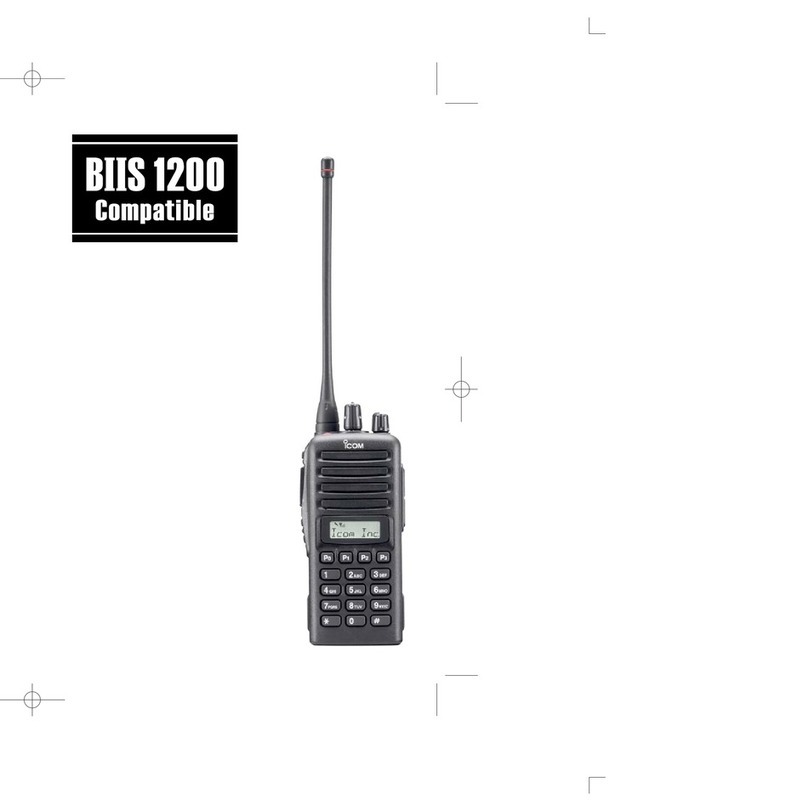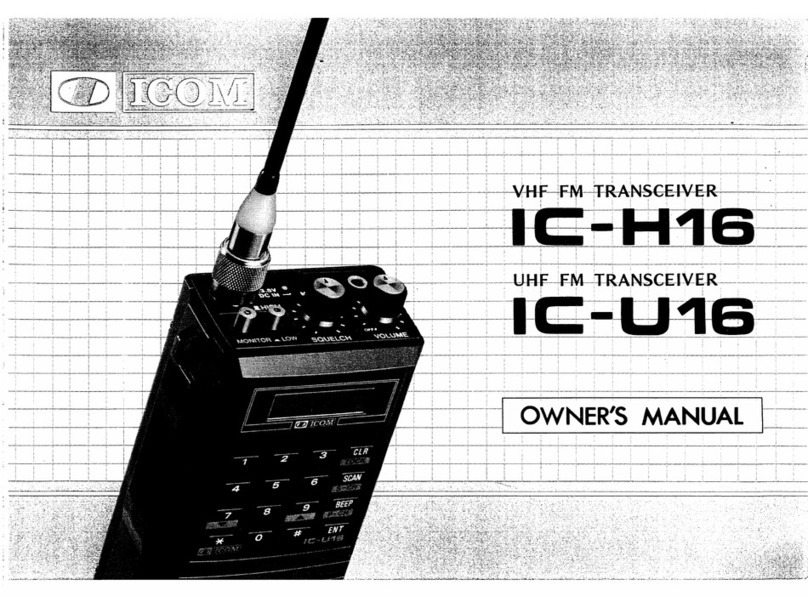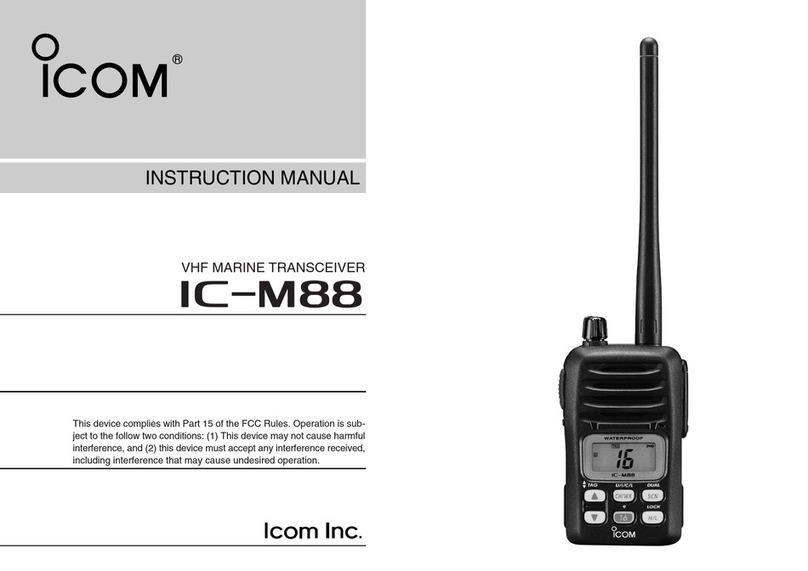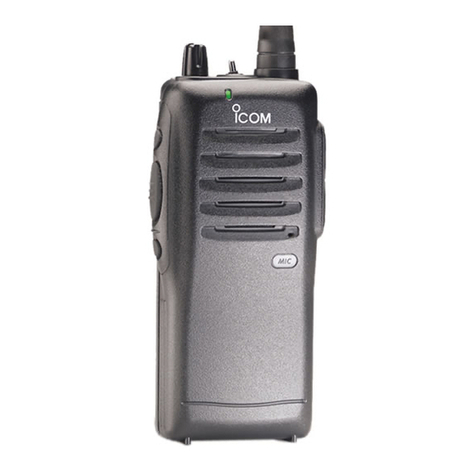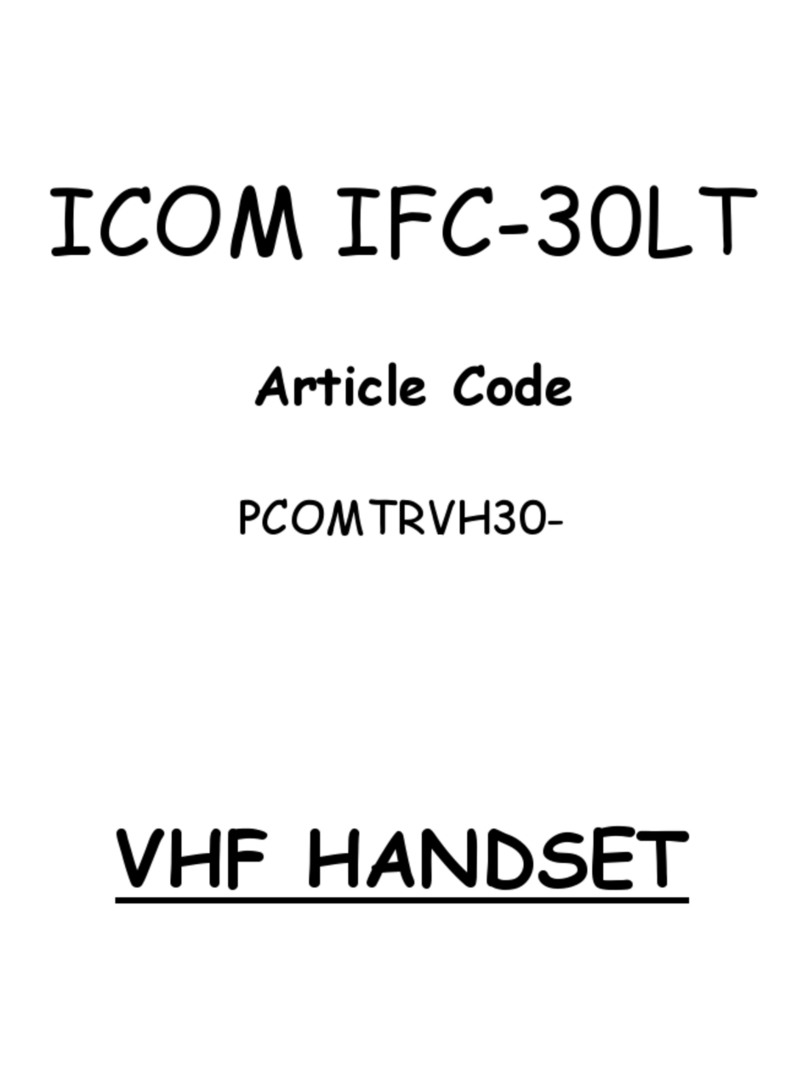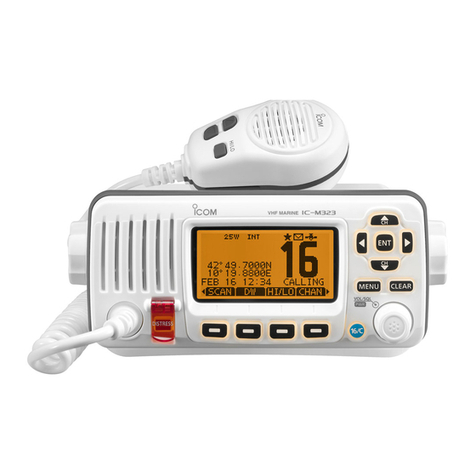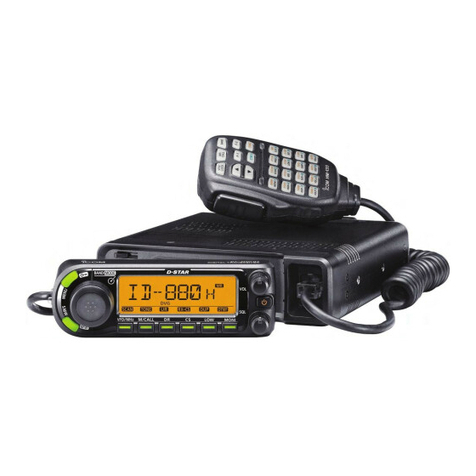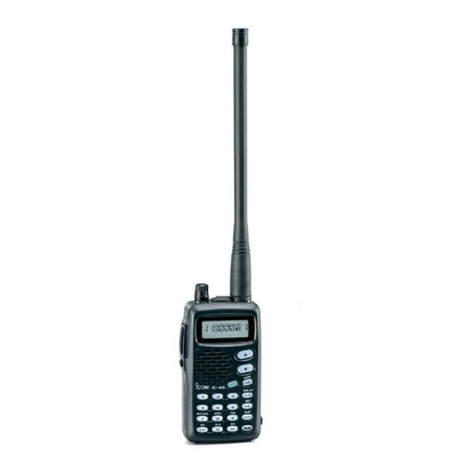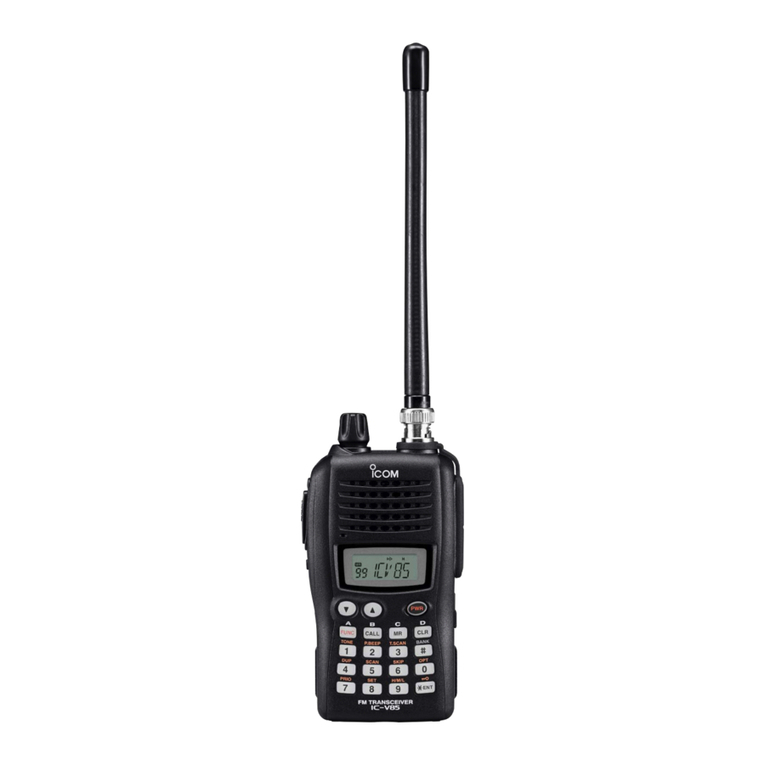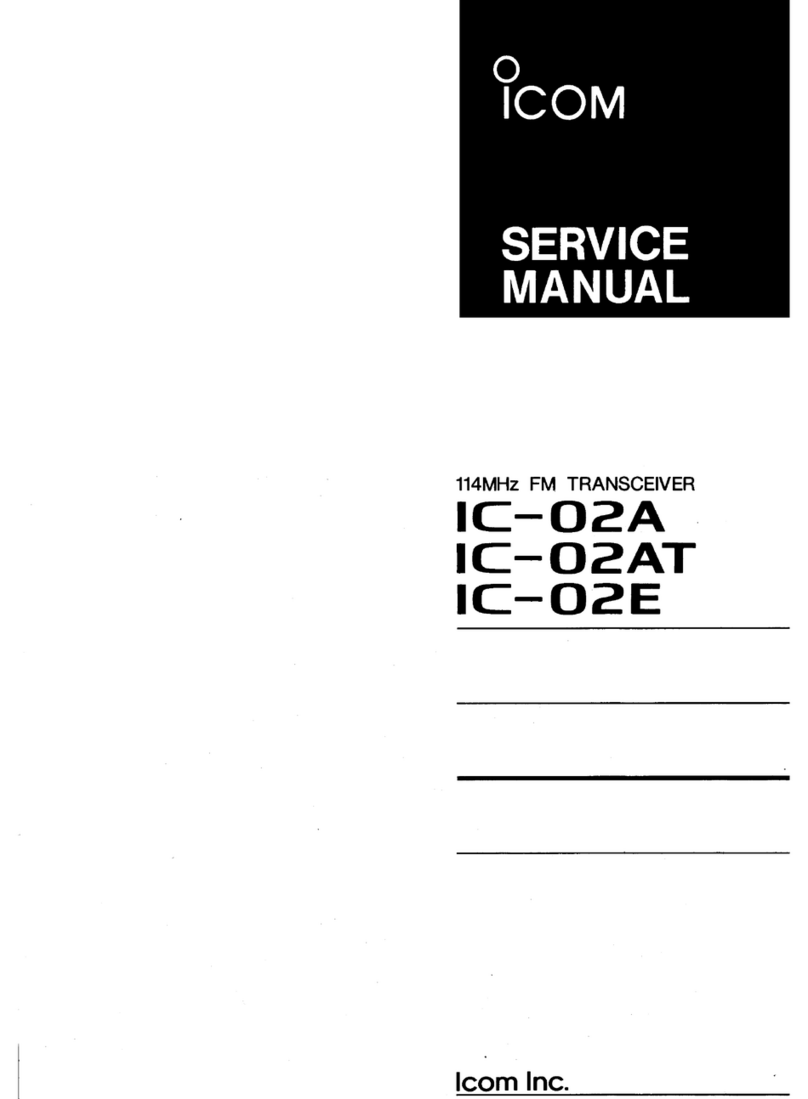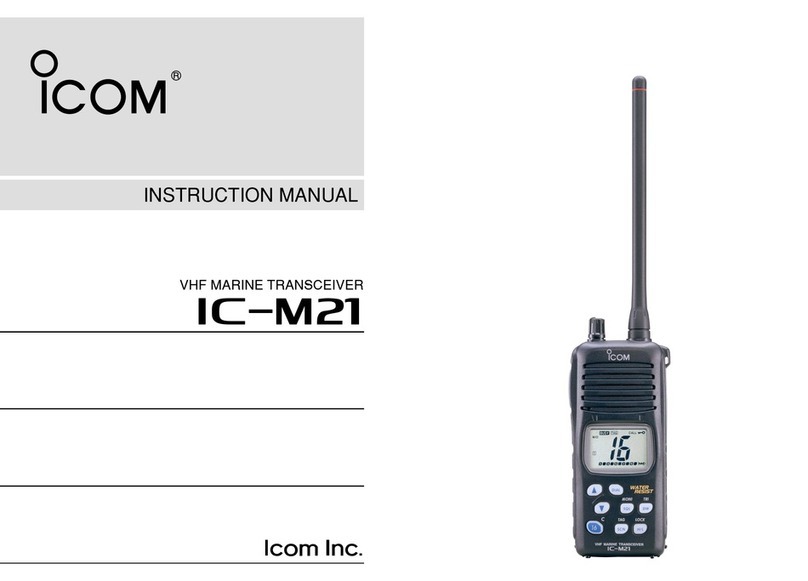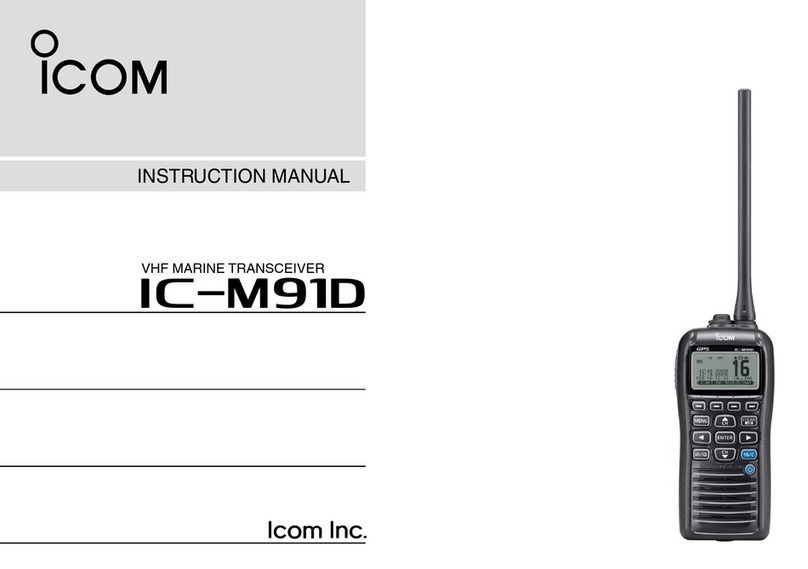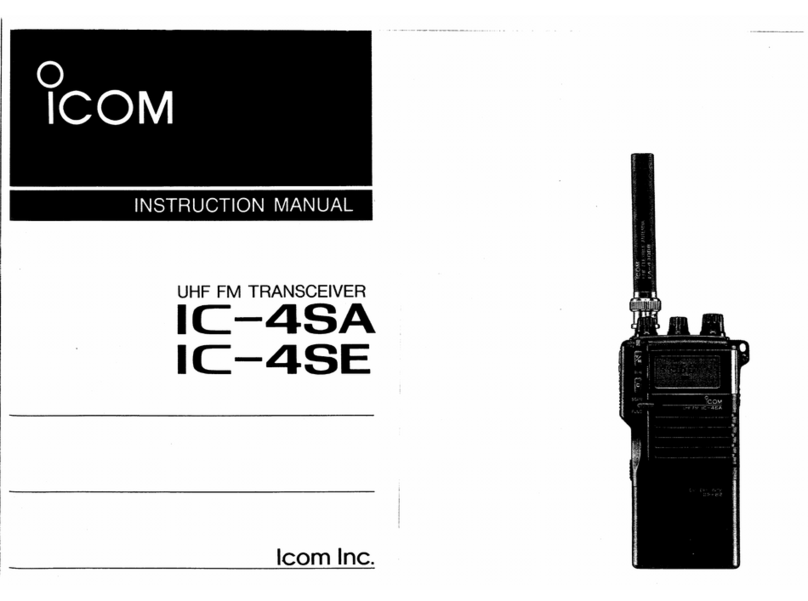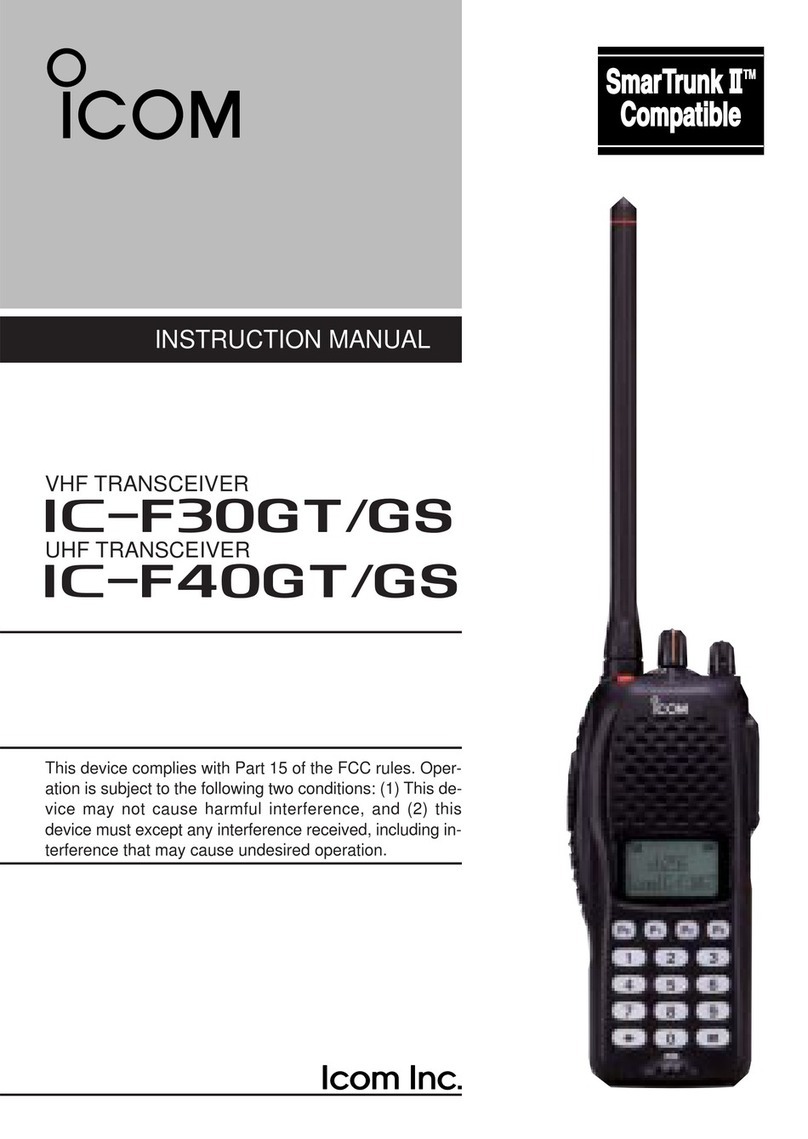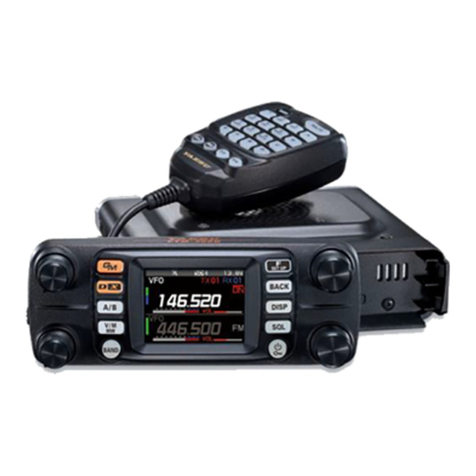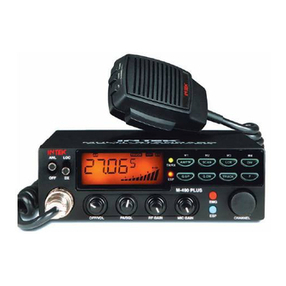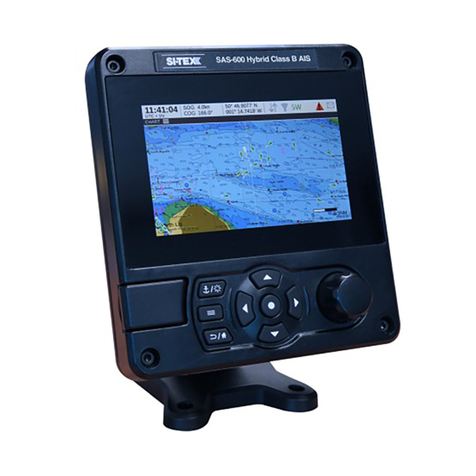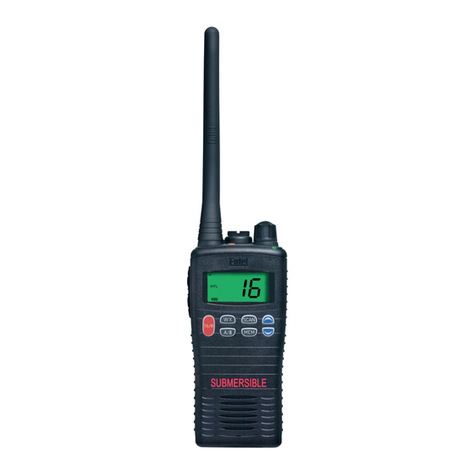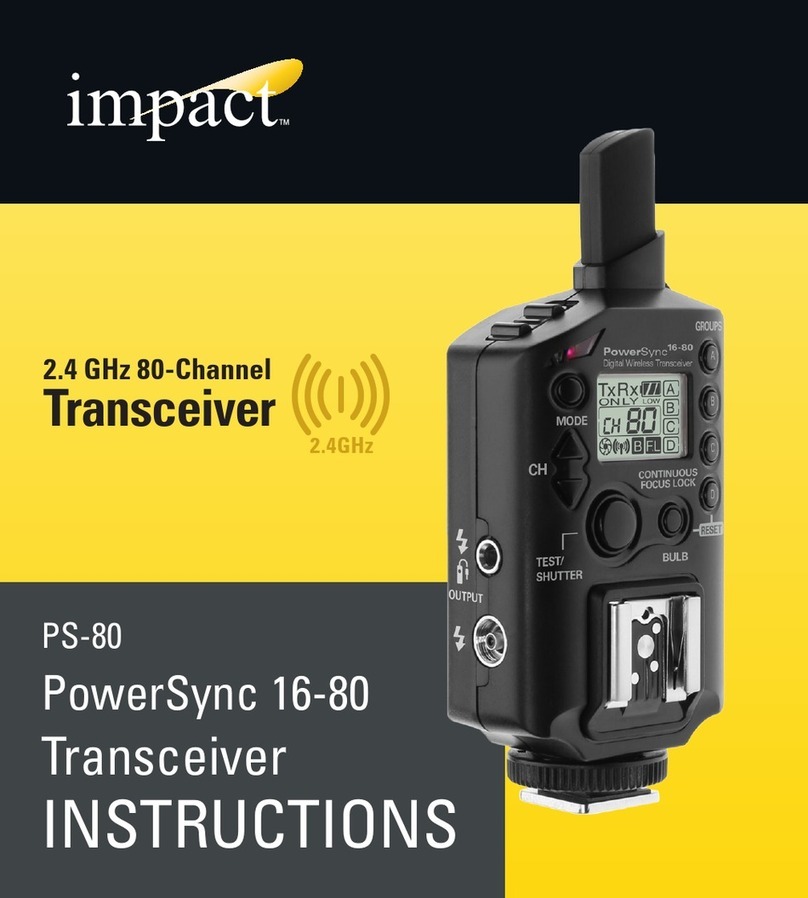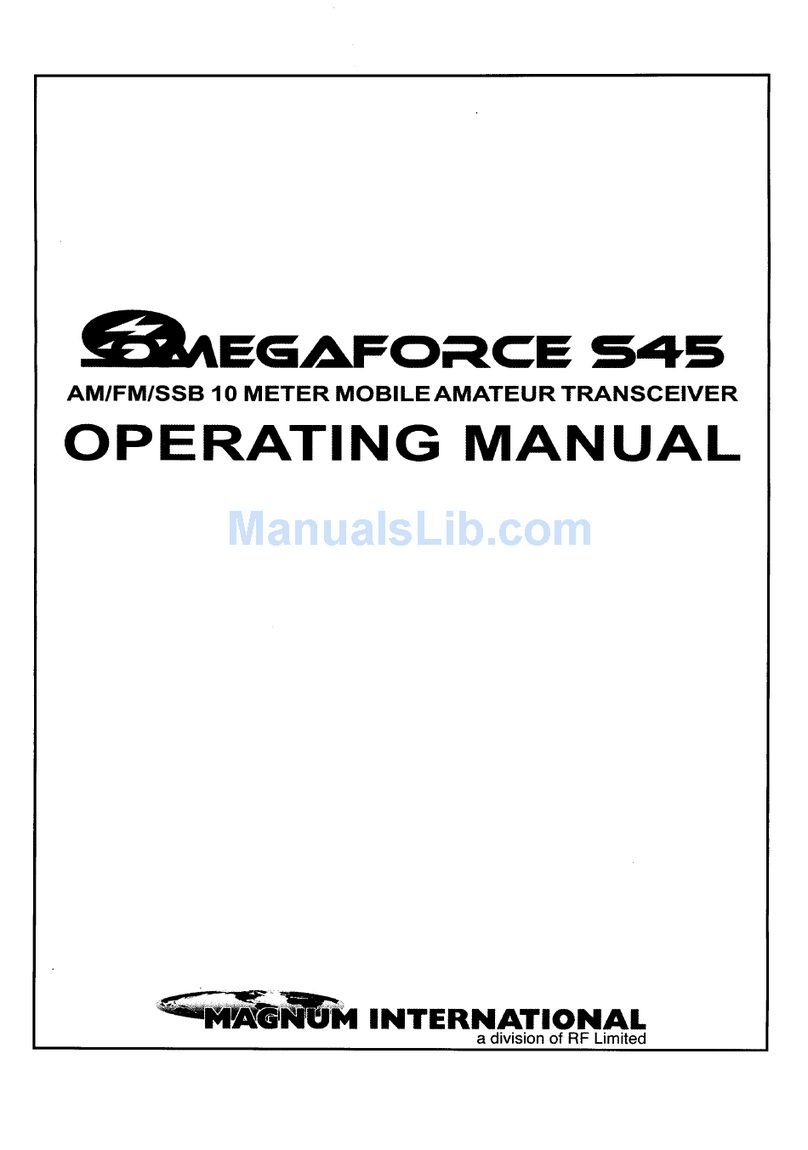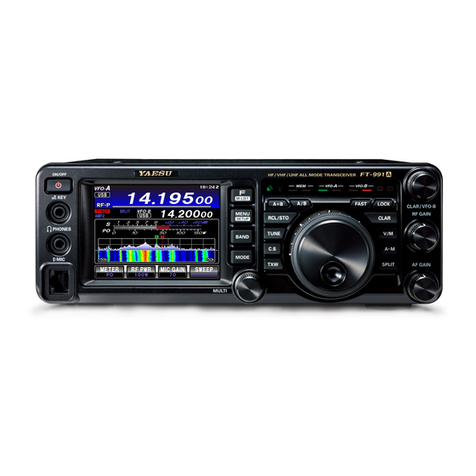Icom IC-446S User manual

INSTRUCTION MANUAL
PMR446 FM TRANSCEIVER
i446S
IC-446S-(5) 02.3.11 4:18 PM Page 33 (1,1)

i
FOREWORD
Thank you for purchasing the IC-446S PMR (Private Mobile
Radio) FM transceiver. This PMR FM transceiver meets the Eu-
ropean PMR specification (PMR446). This transceiver is de-
signed for those who require top-grade quality, performance
and outstanding reliability under the most demanding condi-
tions.
FEATURES
●
Free of user-license and applications
●
All 8 PMR channels are available
●
38 convenient group channels
●
Water-resistant construction
●
500 mW (ERP) High output power
■ATS (Automatic Transponder System)
This convenient function automatically checks station availability
within the operating range, and alerts you via function display in-
dication. (p. 17)
In addition, a manual transponder is also available for “GROUP
MODE” operation to check availability of stations in a specified
group within the operating range. In this case, the transceiver
alerts you via beeps. (p. 14)
IC-446S-(5) 02.3.11 4:17 PM Page 2 (1,1)

ii
■WATER-RESISTANT* CONSTRUCTION
Water-resistant* construction is employed. Can be used any-
where, anytime.
*Meets JIS water-protection specification grade 4.
■GROUP MODE (BUILT-IN CTCSS: Continuous Tone
Coded Squelch System)
CTCSS encoder/decoder are standard, providing quiet stand-by.
Audio (voice) signals are output only when a signal with matched
CTCSS tone signal is received—very helpful for group commu-
nications. In addition, 38 different CTCSS frequencies are avail-
able. (p. 11)
■2 types of “Ring” function
The “Smart-Ring” function and the “Call-Ring” function are avail-
able for smart and simple station calls providing a telephone-
style ring when called. 10 different ringing tones are available.
(p. 14)
SUPPLIED ACCESSORIES
• Belt clip . . . . . . . . . . . . . . 1 set
IC-446S-(5) 02.3.11 4:17 PM Page 3 (1,1)

iii
IMPORTANT
READ ALL INSTRUCTIONS carefully and completely
before using the transceiver.
SAVE THIS INSTRUCTION MANUAL–This instruction
manual contains important operating instructions for the
IC-446S PMR FM transceiver.
CAUTIONS
RWARNING! NEVER hold the transceiver so that the an-
tenna is very close to, or touching exposed parts of the body,
especially the face or eyes, while transmitting. The transceiver
will perform best if the microphone is 5 to 10 cm (2 to 4 in.)
away from the lips and the transceiver is vertical.
RWARNING! NEVER operate the transceiver with a
headset or other audio accessories at high volume levels.
DO NOT push the PTT when not actually desiring to transmit.
DO NOT modify the transceiver for any reason.
AVOID using or placing the transceiver in direct sunlight or in
areas with temperatures below –20°C (–4°F) or above +55°C
(+131°F). In an extreme low temperature environment (around
–20°C), the capacity of Alkaline or dry cell batteries may ex-
haust quickly. In such case, we recommend to replace the bat-
teries, when the “Low Battery Indicator” appears during
transmission.
The use of non-Icom battery packs/chargers may impair trans-
ceiver performance and invalidate the warranty.
IC-446S-(5) 02.3.11 4:17 PM Page 4 (1,1)

iv
TABLE OF CONTENTS
FOREWORD . . . . . . . . . . . . . . . . . . . . . . . . . . . . . . . . . . . . . . . . . . . .i
FEATURES . . . . . . . . . . . . . . . . . . . . . . . . . . . . . . . . . . . . . . . . . . .i–ii
SUPPLIED ACCESSORIES . . . . . . . . . . . . . . . . . . . . . . . . . . . . . . . .ii
IMPORTANT . . . . . . . . . . . . . . . . . . . . . . . . . . . . . . . . . . . . . . . . . . .iii
CAUTIONS . . . . . . . . . . . . . . . . . . . . . . . . . . . . . . . . . . . . . . . . . . . . .iii
TABLE OF CONTENTS . . . . . . . . . . . . . . . . . . . . . . . . . . . . . . . . . . .iv
1 PANEL DESCRIPTION . . . . . . . . . . . . . . . . . . . . . . . . . . . . . . . .1–3
‘Switches, controls, keys and connectors . . . . . . . . . . . . . . . .1–2
‘Function display . . . . . . . . . . . . . . . . . . . . . . . . . . . . . . . . . . . . .3
2 ACCESSORIES . . . . . . . . . . . . . . . . . . . . . . . . . . . . . . . . . . . . . . . .4
3 BATTERY PACKS . . . . . . . . . . . . . . . . . . . . . . . . . . . . . . . . . . . .5–7
‘Installing batteries in the battery case . . . . . . . . . . . . . . . . . . . .5
‘Battery pack charging . . . . . . . . . . . . . . . . . . . . . . . . . . . . . . . . .6
‘ Battery pack life . . . . . . . . . . . . . . . . . . . . . . . . . . . . . . . . . . . . .6
‘Battery pack CAUTION . . . . . . . . . . . . . . . . . . . . . . . . . . . . . . .6
‘Charging connections . . . . . . . . . . . . . . . . . . . . . . . . . . . . . . . . .7
44 BBAASSIICCOOPPEERRAATTIIOONN .. .. .. .. .. .. .. .. .. .. .. .. .. .. .. .. .. .. .. .. .. .. .. .. .. .. .. .. .. .. .. .. .. ..8–9
‘Power ON . . . . . . . . . . . . . . . . . . . . . . . . . . . . . . . . . . . . . . . . . .8
‘Adjusting the volume . . . . . . . . . . . . . . . . . . . . . . . . . . . . . . . . .8
‘Selecting the operating channel . . . . . . . . . . . . . . . . . . . . . . . . .9
5 RECEIVE AND TRANSMIT . . . . . . . . . . . . . . . . . . . . . . . . . . . . .10
6 GROUP MODE (CTCSS) . . . . . . . . . . . . . . . . . . . . . . . . . . . . .11-13
‘Setting the group code . . . . . . . . . . . . . . . . . . . . . . . . . . . . . . .11
7 RING FUNCTION . . . . . . . . . . . . . . . . . . . . . . . . . . . . . . . . . . . . .14
‘Smart-Ring . . . . . . . . . . . . . . . . . . . . . . . . . . . . . . . . . . . . . . . .14
‘Call-Ring . . . . . . . . . . . . . . . . . . . . . . . . . . . . . . . . . . . . . . . . . .14
8 OTHER FUNCTIONS . . . . . . . . . . . . . . . . . . . . . . . . . . . . . . .15–19
‘Initial set mode . . . . . . . . . . . . . . . . . . . . . . . . . . . . . . . . . .15–16
‘ATS (Automatic transponder system) . . . . . . . . . . . . . . . . . . . .17
‘Low battery indicator . . . . . . . . . . . . . . . . . . . . . . . . . . . . . . . .17
‘LCD backlight . . . . . . . . . . . . . . . . . . . . . . . . . . . . . . . . . . . . . .18
‘Auto power save . . . . . . . . . . . . . . . . . . . . . . . . . . . . . . . . . . . .18
‘Resetting the transceiver . . . . . . . . . . . . . . . . . . . . . . . . . . . . .18
‘Optional HM-75A functions . . . . . . . . . . . . . . . . . . . . . . . . . . . .19
9 SPECIFICATIONS . . . . . . . . . . . . . . . . . . . . . . . . . . . . . . . . . . . . .20
10 OPTIONS . . . . . . . . . . . . . . . . . . . . . . . . . . . . . . . . . . . . . . . . . .21
11 MEMO . . . . . . . . . . . . . . . . . . . . . . . . . . . . . . . . . . . . . . . . . .22-24
‘Channel number and group number . . . . . . . . . . . . . . . . . . . .22
12 CE . . . . . . . . . . . . . . . . . . . . . . . . . . . . . . . . . . . . . . . . . . . . .25-26
‘DECLARATION OF CONFORMITY . . . . . . . . . . . . . . . . . . . . .26
IC-446S-(5) 02.3.11 4:17 PM Page 5 (1,1)

1
1PANEL DESCRIPTION
‘‘Switches, controls, keys and connectors
qANTENNA
w[PTT]
e[UP]
r[DOWN]
tSPEAKER
!0 [VOL]
oFUNCTION
DISPLAY
i[POWER]
u[MODE]
yMIC
!1 SP/MIC
JACKS
IC-446S-(5) 02.3.11 4:17 PM Page 6 (1,1)

2
PANEL DESCRIPTION 1
3
qANTENNA
Extend the antenna completely when using the transceiver.
• The antenna collapses completely into the transceiver body for car-
rying purposes.
• The antenna can be adjusted 90 degrees from the regular position
when operating the transceiver in a horizontal position.
wPTT SWITCH [PTT]
• Push and hold to transmit; release to receive.
eCHANNEL UP SWITCH [UP]/[Y]
• Push to increment the operating channel.
• Push and hold to increment the operating channel continuously.
rCHANNEL DOWN SWITCH [DOWN]/[Z]
• Push to decrement the operating channel.
• Push and hold to decrement the operating channel continuously.
tSPEAKER
yMICROPHONE [MIC]
uMODE SWITCH [MODE]
• Push to toggle between Group mode and Normal mode. (p. 11)
• Push and hold for 1 sec. to force the squelch open; push and hold for 1
sec. to close it again. (p. 8)
iPOWER SWITCH [POWER]
• Push to turn the power ON.
• Push and hold this key to toggle the key lock function ON/OFF.
(p. 16)
oFUNCTION DISPLAY (p. 3)
!0 VOLUME CONTROL [VOL]
Rotate clockwise to increase and counterclockwise to decrease volume.
!11 EXTERNAL SPEAKER AND MICROPHONE JACKS
Connect an optional speaker-microphone or headset, if desired.
IC-446S-(5) 02.3.11 4:17 PM Page 7 (1,1)

3
1PANEL DESCRIPTION
‘‘Function display
qTRANSMIT INDICATOR
Appears during PTT on.
wBUSY INDICATOR
Appears while receiving a signal or when the squelch is open.
eKEY LOCK INDICATOR
Appears during key lock function ON.
rAUTO POWER OFF INDICATOR
Appears while the auto power off function is ON. (see p. 15)
tLOW BATTERY INDICATOR
Appears or flashes when battery power has decreased to a specified
level.
yGROUP NUMBER INDICATION
One of 01 to 38 appear while the Group function is turned ON.
uCHANNEL NUMBER INDICATOR
Indicates operating channel number.
iPOWER ON INDICATOR
Appears while the power is ON.
oANSWER BACK INDICATOR (see p. 17)
• Appears when you and your group are in the conversation area.
• Blinks when you or your group is out of the conversation area.
qwe
rt
i
ouy
IC-446S-(5) 02.3.11 4:17 PM Page 8 (1,1)

4
ACCESSORIES 2
DAntenna
Adjust the antenna position as
shown at right.
Keep the jack cover attached
when jacks are not in use to
avoid bad contacts.
DBelt clip
Attach the belt clip using the
supplied screws. Conveniently
attaches to your belt.
‘‘Accessory attachment
IC-446S-(5) 02.3.11 4:17 PM Page 9 (1,1)

5
3BATTERY PACKS
‘‘Installing batteries in the battery
case
Install 3 R6(AA) size alkaline, dry cell batteries or the BP-202 BAT-
TERY PACK as illustrated below.
qRemove the battery
case cover from the
transceiver.
wInstall 3×R6(AA) size
dry cell, alkaline bat-
teries or the BP-202.
• Be sure to observe
the correct polarity.
NOTE: Keep battery con-
tacts clean. It’s a good
idea to clean battery ter-
minals once a week.
BP-202
IC-446S-(5) 02.3.11 4:17 PM Page 10 (1,1)

6
BATTERY PACKS 3
7
‘‘Battery pack charging
The optional BP-202 BATTERY PACK includes rechargeable Ni-Cd
batteries and can be charged approx. 300 times. Charge the battery
pack before first operating the transceiver or when the battery pack
becomes exhausted.
If you want to be able to charge the battery pack more than 300
times, the following points should be observed:
1. Avoid overcharging. The charging period should be less than 48
hours.
2. Use the battery until it becomes almost completely exhausted
under normal conditions. We recommend battery charging just
after transmitting becomes impossible.
‘‘Battery pack life
If your battery pack seems to have no capacity even after being
fully charged, completely discharge it by leaving the power ON all
day. Then, fully charge the battery pack again.
If the battery pack still does not retain a charge (or very little), a new
battery pack must be purchased.
‘‘Battery pack CAUTION
NEVER short terminals of the battery pack (or charging terminals of
the transceiver). Also, current may flow into nearby metal objects,
so be careful when placing battery packs ( or the transceiver) in
handbags, etc. Simply carrying with or placing near metal objects
such as necklace, etc. causes shorting. This will damage not only
the battery pack but also the transceiver.
IC-446S-(5) 02.3.11 4:17 PM Page 11 (1,1)

7
3BATTERY PACKS
*
‘‘Charging connections
DRapid charging with the BC-119L/BC-119+AD-89
qInsert the optional AD-89 DESKTOP CHARGER ADAPTER into
the charging slot of the BC-119.
• The BC-119L comes preinstalled with the AD-89 CHARGING
ADAPTER.
wInsert the battery pack, either by itself or attached to the trans-
ceiver, into the charger.
(See BC-119/L instructions.)
BC-119
AD-89
BP-202
AC adapter
IC-446S
*NOTE: Put the Ni-Cd
battery adapter into the
AD-89 rear slot when
the BP-202 is attached
to the transceiver.
IC-446S-(5) 02.3.11 4:17 PM Page 12 (1,1)

8
BASIC OPERATION 4
9
‘‘Power ON
➥Push [POWER] for 1sec. to turn the
power ON.
• The power on indicator and oper-
ating channel number appear on
the display.
‘‘Adjusting the volume
qPush and hold [MODE] for
1sec. to open the squelch.
• Busy indicator appears on
the display while the squelch is
open.
wAdjust the audio to a suitable level
using [VOL].
ePush and hold [MODE] for 1sec. to
close the squelch.
✔What is squelch?
A squelch circuit allows you to mute undesired noise while re-
ceiving no signal and emit audio while receiving signals.
This provides quiet standby. The [MODE] key changes the
squelch setting. This is useful to listen to weak signals that do
not open the squelch.
w
e
q
UP
DOWN
MODE
POWER
Busy indicator
appears.
UP
DOWN
MODE
POWER
IC-446S-(5) 02.3.11 4:17 PM Page 13 (1,1)

4BASIC OPERATION
9
‘‘Selecting the operating channel
Push [UP]/[Y] or [DOWN]/[Z] keys sev-
eral times until the desired operating
channel number appears on the dis-
play.
• While pushing and holding [UP]/[Y] or
[DOWN]/[Z] keys, the displayed chan-
nel changes continuously until chan-
nel number “ 1 ” appears.
If you want to keep the automatic se-
lection, release the [UP]/[Y] or
[DOWN]/[Z] keys then push and hold them again.
• When displayed channel stops at channel number “1”, a warning
beep is emitted.
NOTE:
• The transceiver has 8 operating frequency channels.
• The selected channel is memorised when you turn off the
transceiver.
• The transceiver has an auto power save function to conserve
the battery power. The power save function activates automat-
ically when no signal is received for 5 sec.
UP
DOWN
MODE
POWER
IC-446S-(5) 02.3.11 4:17 PM Page 14 (1,1)

10
RECEIVE AND TRANSMIT 5
qPush and hold [MODE] 1sec.
to open the squelch.
•Adjust volume to the desired
audio level. (See p. 8)
wSelect a desired operating channel.
When a signal is received:
•Squelch opens and audio is emitted
from the speaker.
•Further adjustment of [VOL] may be
necessary at this point.
•“BUSY”indicator appears on the dis-
play.
ePush and hold [PTT] to transmit then
speak into the microphone.
•Do not hold the transceiver too close
to your mouth or speak too loudly.
This may distort the signal.
•The transmit indicator “”appears
on the display.
rRelease [PTT] to return to receive.
Time-Out Timer (TOT)
The transceiver has time-out timer function. This function pre-
vent continuous, extend transmissions. This timer turns a trans-
mission OFF 3 min. after it starts.
A warning beep sounds 10 sec. before the limit is reached and
the time-out timer turns OFF the transmission automatically. The
end beep emits to announce the end of the transmission.
UP
DOWN
MODE
POWER
UP
DOWN
MODE
POWER
Busy indicator
appears.
IC-446S-(5) 02.3.11 4:17 PM Page 15 (1,1)

11
6GROUP MODE (CTCSS)
‘‘Setting the group code
The IC-446S is equipped with 38 group codes. Group mode oper-
ation provides communication with silent standby since you will only
receive calls from group members using the same group number.
First of all, set the same group code number for all group member’s
transceivers.
Turn ON the group mode operation:
qPush [MODE] to enter set mode.
•“--- ”(group mode OFF) appears on
the display.
wPush [UP]/[Y] or [DOWN]/[Z] to select
the desired code number.
ePush [MODE] to set the group code
number.
Cancel the group mode operation:
qPush [MODE] to enter set mode.
•Code number disappears on the dis-
play.
wPush [UP]/[Y] or [DOWN]/[Z] to select
“--- ”(group mode OFF).
ePush [MODE] to cancel the group
mode.
NOTE: Only stations with the same
group channel number can be heard during group mode opera-
tion, even when the busy indicator appears on the display.
UP
DOWN
MODE
POWER
q
w
w
IC-446S-(5) 02.3.11 4:17 PM Page 16 (1,1)

12
GROUP MODE (CTCSS) 6
13
✔What is CTCSS (Continuous Tone Coded Squelch Sys-
tem) GROUP MODE ?
CTCSS (Continuous Tone Coded Squelch System) GROUP
MODE allows communication with silent stand by. Only signals
containing your group code can open the squelch.
This conveniently eliminates unwanted audio and is useful in
group activities or security related activities where unwanted
output can be a problem. Note that CTCSS group mode is not
private—anyone can receive your calls.
The IC-446S is equipped with 38 tone codes for CTCSS
GROUP MODE use. Selecting a code applies it to all 8 oper-
ating channels. Each push of [PTT] superimposes your group
code over your transmit signal; and, only signals containing the
same code can open your squelch. To temporarily hear all sig-
nals (including noise) push and hold [MODE]. Do not use
CTCSS GROUP MODE if you want to be able to hear signals
on all channels.
IC-446S-(5) 02.3.11 4:17 PM Page 17 (1,1)

6GROUP MODE (CTCSS)
13
DCTCSS code table
✔Talk Range
The IC-446S is designed to maximize performance and im-
prove transmission range in the field. However, the single
most important factor in transmit range (talk power) is your
surrounding environment. These radios are “line of sight”ra-
dios and as such, transmission range is influenced by the de-
gree to which you can “see”the other communicating party.
Large concrete structures and heavy foliage or transmission
from inside a building or vehicle will reduce your talk power.
•Optimal range: wide, open areas free of obstructions.
•Medium range: large buildings or trees blocking your line of
sight.
•Minimum range: mountainous areas or areas of heavy fo-
liage.
(unit: Hz)
01
02
03
04
05
06
07
08
09
10
67.0
71.9
74.4
77.0
79.7
82.5
85.4
88.5
91.5
94.8
11
12
13
14
15
16
17
18
19
20
21
22
23
24
25
26
27
28
29
30
31
32
33
34
35
36
37
38
---
97.4
100.0
103.5
107.2
110.9
114.8
118.8
123.0
127.3
131.8
136.5
141.3
146.2
151.4
156.7
162.2
167.9
173.8
179.9
186.2
192.8
203.5
210.7
218.1
225.7
233.6
241.8
250.3
OFF
CH Freq. CH Freq. CH Freq. CH Freq.
IC-446S-(5) 02.3.11 4:17 PM Page 18 (1,1)

14
RING FUNCTION 7
‘‘Smart-Ring
The ring function has an answer back feature. This allows you to
confirm whether or not a call has reached the receiving party even
if the operator is temporarily away from the transceiver.
qSet the same group channel number for
all of your group transceivers. (See left.)
wWhile pushing [PTT], push [UP]/[Y] .
•A beep is emitted and “”blinks on
the display.
eRelease the [PTT].
•When a member of your group an-
swers your call, the transceiver emits
beep tones for 10 sec. and blinks “”.
•When no answer comes back, the
transceiver emits short faint beep tones.
rPush [PTT] to answer and to stop the beeps and flashing.
NOTE: This function is available only when the called station
has set the same group number and the same operating chan-
nels as you.
‘‘Call-Ring
Sends the ring tones during transmit
mode.
➥While pushing [PTT], push [DOWN]/[Z]
to send a ring tone.
•The ring tone is emitted while pushing
[DOWN]/[Z].
•The microphone signal is automati-
cally cut while pushing [DOWN]/[Z].
UP
DOWN
MODE
POWER
UP
DOWN
MODE
POWER
IC-446S-(5) 02.3.11 4:17 PM Page 19 (1,1)

15
8OTHER FUNCTIONS
‘‘Initial set mode
Initial set mode is accessed at power ON and allows you to set sel-
dom changed settings. In this way you can “customize”transceiver
operations to suit your preferences and operating style.
DAuto power OFF
This function sets the transceiver to auto-
matically turn OFF after 2 hours elapse.
qWhile pushing [MODE], push [POWER]
ON to toggle the function ON or OFF.
w““appears on the display.
•“Auto power OFF”function retains its
setting after power OFF.
DRing tone type
You can select the ring tone from one of
10 sounds.
qWhile pushing [UP]/[Y], push [POWER]
ON.
wPush [UP]/[Y] or [DOWN]/[Z] to select
the ring sound.
DBeep tones ON/OFF
Confirmation beep tones normally sound
when you push a key. These can be
turned ON or OFF.
➥While pushing [DOWN]/[Z], push
[POWER].
UP
DOWN
MODE
POWER
UP
DOWN
MODE
POWER
qq
w
w
UP
DOWN
MODE
POWER
IC-446S-(5) 02.3.11 4:17 PM Page 20 (1,1)
Table of contents
Other Icom Transceiver manuals
Popular Transceiver manuals by other brands

Fiio
Fiio Pro BTA30 quick start guide
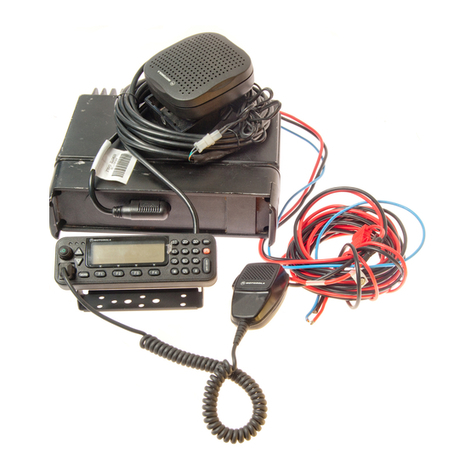
Motorola
Motorola MICOM-2E ALE owner's guide

Radio Shack
Radio Shack TRC-506 user guide

Kenwood
Kenwood TM-2530A instruction manual

Thrane&Thrane
Thrane&Thrane TT-3026L easyTrack installation manual
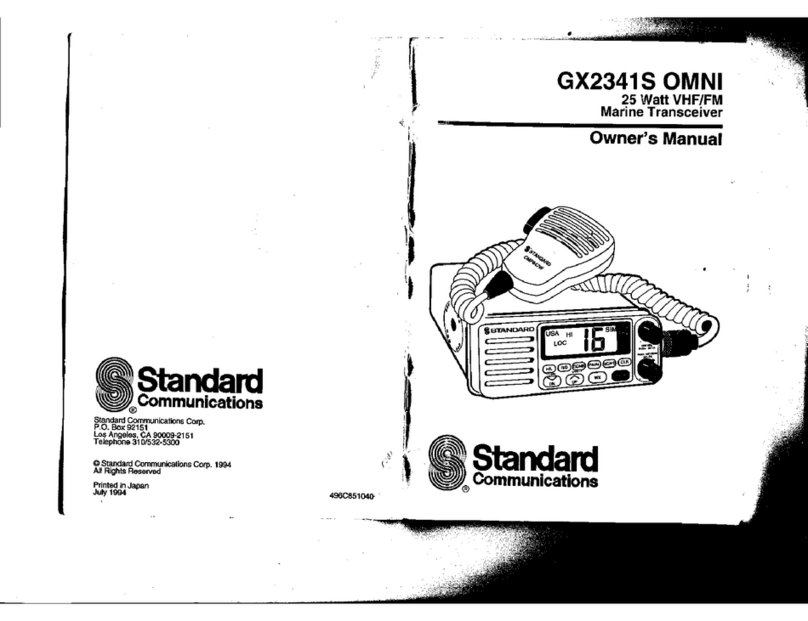
Standard Communications
Standard Communications GX2341S OMNI owner's manual
